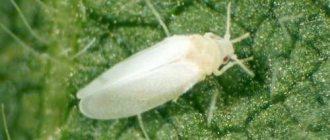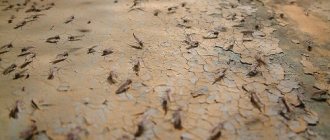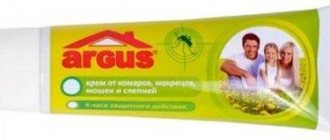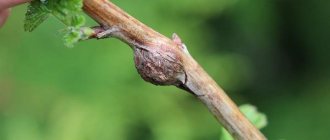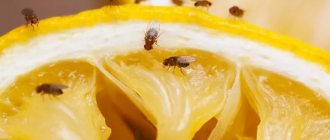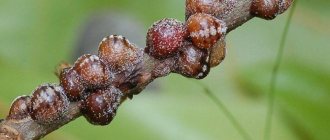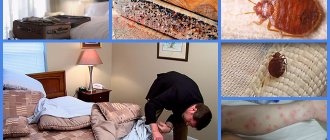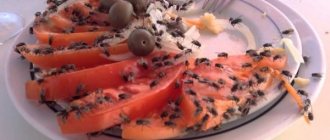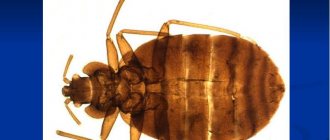Cockroaches, ants, bedbugs, spiders - these are just some of the species of fauna that often live in apartments. For example, in a bathroom with high humidity, midges also appear. Winged neighbors are lured by sewage settling on the inside of water drains. This is where sewer midges get their name. If you notice small black dots on the ceiling in the bathroom or on the surface of the plumbing, you need to immediately begin fighting insects. They multiply quickly, and within a couple of days a whole swarm of pests will be flying around the room.
Description and reasons for the appearance of midges in the bathroom
The sewer midge ( butterfly ) is a miniature insect, similar to a mini-copy of a clothes moth (no more than 5 millimeters). Along with its smaller dimensions, the pest has a second distinctive feature - a black body. Butterfly is the collective name for midges. This family includes more than 2,500 species distributed on all continents.
Archaeologists often find the remains of butterflies in rocks from the Jurassic period. Since then, the pest has changed little. Of course, there was no sewage system in that era, so the midge lived in the wild, content with the humidity and putrefactive processes occurring in the environment.
The small female releases pheromones to attract males. The human nose is unable to detect them. However, the substance often provokes an exacerbation of allergies. Often, apartment residents complain of dipteran insect bites. In reality, the mouthparts of sewer flies are not able to bite through the skin. The appearance of spots and itching is a manifestation of an allergic reaction.
Reproduction after mating occurs at lightning speed. When the female has laid a clutch, the larvae hatch within 2 days (sometimes earlier). It takes 1-2 weeks for the new generation to reach maturity.
The most obvious reason for the appearance of sewer midges in the bathroom is unsanitary conditions. However, the insect is attracted by a number of additional factors:
- proximity to contaminated premises (midges can enter from basements and residential apartments if there is an abundance of mold in them);
- the presence of constant blockages in the pipes (high humidity, leaks, heat, an abundance of food will certainly attract a couple of winged individuals and soon the bathroom will begin to infest with pests);
- keeping indoor plants in the bathroom;
- rarely emptying the trash can;
- presence of expired cosmetics on the shelf;
- rare cleaning of the pet's toilet (provided that the tray is in the bathroom);
- flowering trees growing under the windows, a garbage chute or waste bins located in the immediate vicinity of the apartment.
Washing fruits in the bathroom provokes the appearance of sewer midges. Inevitably, particles of fruit end up in the drain. There they begin to rot, attracting small midges.
Sewer midges enter the house through different channels. More often they happen to fly into a room through a window. Often, apartment owners themselves introduce insects on clothes/shoes or with food. If the source of infection is located in the same entrance, the fly will enter through the door or window cracks. Small dimensions give the pest the opportunity to squeeze through the smallest cracks in the floor and communications.
Sewer midges are considered harmless insects. They do not damage property in the house, do not bite owners, limiting themselves to causing aesthetic discomfort. Some entomologists even consider butterflies to be useful neighbors. Larvae and adults feed on mucus and waste residues accumulated in the pipes. Large populations of midges destroy sewer blockages.
Some experts remain concerned that sewer midges can contaminate food in the kitchen with dangerous microorganisms (there is no scientifically proven evidence). Theoretically, such a possibility cannot be excluded, given where small flyers spend most of their time. Therefore, if you notice several dark spots in the bathroom, it is better to immediately begin to confront the uninvited guests.
What harm do midges cause?
Numerous midges in an apartment can appear suddenly, multiply quickly and greatly annoy people with their presence. The food supply of fruit flies is plant debris, including rotting parts of indoor plants. Sewer flies and fruit flies can infect food and various surfaces in the apartment.
On their legs and abdomen, insects carry pathogenic viruses, fungi and bacteria from trash cans and pipes.
Adult sciarids hardly feed. Females lay eggs on indoor plants and on the surface of the ground. Fungus gnat larvae are voracious and omnivorous. They live in earthen substrates, feed on soil fungi and plant debris, and if there is a lack of this food, they switch to eating roots and seedlings.
It is necessary to use all means and methods to get rid of midges at home and in the office. Adults and larvae suck out plant juices and inject their poisonous saliva. Midges carry infections (viral, bacterial, fungal), mites, and nematodes.
One adult female sciarid lays up to 300 eggs. If midges find an abundance of food in the apartment and do not meet resistance from the owners, they multiply very quickly. Fighting these insects is not an easy task, because they hide well and increase their numbers many times over in a short period of time.
Traditional methods of dealing with sewer midges
Fighting butterflies is much easier than getting rid of cockroaches and other worst indoor pests. Almost any store-bought or homemade insect repellent will help destroy the flyer. The only exception to the rules is compositions intended for spot application (pencils, gels, crayons, powders). The reason lies in the fact that the way the butterfly moves prevents contact with the insecticide-treated surface. Although, if you improve the composition, making it attractive to sewer midges, then spot application products will also work.
To get rid of sewer midges in one go, you will need to thoroughly sanitize the bathroom:
- Go through bottles and tubes with hygiene products. Pay special attention to formulations with berry or fruit aromatic additives. If you find spoiled or expired copies, dispose of them. For other cosmetics, check the tightness of the lids.
- Check pipes for leaks. If leaks are detected, repair the sewerage defects.
- Provide fresh air flow. Good circulation will speed up the drying process of water and reduce the overall humidity in the bathroom.
- Treat hard-to-reach corners with chlorine compounds. The fly cannot tolerate the smell of the substance and dies. At the same time, such sanitation will help to detect and destroy mold accumulations.
- Clean the pet's toilet, trash can and litter box with any detergent. The smell of feces is as attractive to midges as the gases emitted by rotting fruit.
- Spray with insect repellent aerosol.
In the fight against sewer midges, you will have to combine 2 methods of opposition. An aerosol will work well against flyers. However, the gaseous substance will not be able to penetrate deep into the drainpipe, where the pest larvae live. Filling the drain hole with boiling water, bleach and other aggressive compounds will help get rid of them.
How to make a midge trap from a plastic bottle with your own hands?
To avoid spending money on expensive chemical insect control products, you can try to make your own traps.
How to do:
- You will need a disposable plastic beer glass or a small plastic bottle (preferably with a wide neck).
- Something sweet is placed at the bottom of the bottle, for example, a piece of fruit.
- The neck should be covered with cling film (pressing the edges tightly).
- Using an awl or a needle, make holes in the film (the midges will fly into the glass in search of food, but will not be able to get out of it easily and will not want to, since they will have food).
- Such a glass or bottle should be left for several hours (a third or a quarter of a day, half a day - depending on how many midges you have in the house).
- The “trap” should be changed several times (about 2-4) to completely get rid of insects in the room.
DIY trap
Store-bought remedies for midges in the bathroom
Sewer midges will fall victim to most modern insecticides. Depending on the degree of contamination of the bathroom, different formulation formats are suitable. It is better to remove a large population using aerosols and sprayers. A couple of individuals can be dealt with using adhesive tape. If the first generation has managed to reproduce, it makes sense to place a trap near the suspected nesting site of the pests.
Initially, sticky tapes sold in stores are positioned as remedies for fruit gnats and regular flies. But, according to reviews from those affected by the butterfly, the adhesive base hung around the bathroom copes well with sewer pests.
Examples of brands of adhesive tapes effective against sewer midges:
- Raptor;
- Fumitox;
- Mosquitall;
- Mukhoyar;
- Argus and products from other manufacturers.
The mechanism of action of the tapes is the same - flyers flying by stick to the sticky base with their wings and body. The product will be ineffective if the midges have already laid eggs in the drain pipe. Destruction of adult individuals will give temporary results. And after 1.5-2 weeks, hordes of new flyers will appear in the bathroom (one female can lay up to 50 eggs).
You can use a trap against midges in the bathroom. Often they make it themselves, but stores have ready-to-use devices. They are a plastic container containing a toxin that is non-toxic to humans.
Examples of brands of effective sewer midge traps:
- Vortex;
- Help;
- Smart Way;
- Block;
- Natural Control and others.
The main advantage of traps over adhesive tapes is that insect remains are reliably hidden from view inside the device block. Therefore, using it is more pleasant than hanging adhesive sheets around the perimeter of the bathroom, which by the evening will be covered with flying insects.
It is possible to remove mass accumulations of midges using an aerosol. Insecticides of this format are highly toxic, so it is better to spray the gas while wearing a respirator. Before treatment, you need to remove toothbrushes and other personal hygiene products from the bathroom. After using the aerosol, it is better for apartment owners to leave for a couple of hours. In this case, it is worth setting the window to the “Ventilation” mode. Then, after returning, people do not have to worry about their health.
Examples of brands of effective aerosols against sewer midges:
- Dichlorvos;
- Raid;
- Raptor;
- Gardex;
- Clean house and other means.
The listed products have varying degrees of odor intensity. For example, manufacturers of Raid aerosol claim that you can return to your apartment within 20-30 minutes after spraying.
Sometimes classic sewer pipe sanitation helps get rid of pests. Liquid sewer cleaning products have proven themselves well: Tiret, Mole, Likvazim, etc. They remove mucus and remaining contaminants from the inside of the pipe, depriving midges of food.
Annoying midges from dampness: how to deal with them
One of the main reasons for the appearance of midges in the house is an excess of humidity and dampness in the room. Flying creatures flock and live precisely where it is humid and dark.
If midges appear in the bathroom due to dampness, then you need to ventilate more often and eliminate all sources of moisture
Before you start fighting the annoying midges, you should put things in order in those places that attract them so much:
- Take out the old garbage and do it regularly in the future;
- Clean drain cups and siphons in the sink and in the bathroom;
- Clean existing leaks and repair plumbing;
- Frequently ventilate the bathroom and dry things on the balcony;
- Monitor the condition of indoor plants;
- Frequently clean all, especially hard-to-reach surfaces with cleaning products.
Sewer pipes should be cleaned regularly. This can be done by adding chlorine to the toilet and sink opening.
A fairly simple way to get rid of midges is to use adhesive tapes or strong, repellent odors. Flying insects do not like the aromas of essential oils, various spices, basil and other odorous substances.
Folk life hacks against sewer midges
To destroy annoying midges, environmentally friendly folk remedies are suitable. They can be removed not only with toxic store-bought compounds; substances available in any kitchen can handle the task 100%.
The following measures are considered effective:
- wiping bathroom surfaces with baking soda powder;
- repeated treatment of walls, ceilings, shelves with a concentrated solution of laundry soap or diluted vinegar (100 milliliters per 5-7 liters of water);
- laying out fresh peels of citrus fruits in the corners of the bathroom (the main thing is to prevent mold from appearing on them, otherwise the weapon will quickly reclassify as a lure);
- placing crushed heated camphor (the substance should begin to emit steam) in a tight, closed bathroom;
- a small number of flying individuals are collected with a vacuum cleaner, after which the contents of the bag are immediately placed in a hermetically sealed plastic bag;
- Place a solution of apple cider vinegar and vegetable oil near the places where sewer midges accumulate (the liquid attracts insects with its smell, but stuck wings prevent them from flying off the oily surface).
Homemade traps help remove midges. To prepare them you will need a glass jar. Pour some water into it and place a piece of apple or banana. Insert a paper funnel into the neck (wide end up) and secure it tightly to the glass with tape. The second way is to cover the jar with plastic and make small holes in it. The flight path of midges is such that once they fly inside, the insect is unable to get out.
Proper bathroom hygiene is the main rule for preventing the appearance of sewer midges. To prevent insects from infesting the bathtub, you need to pour bleach or other disinfectants into the drain holes and toilet bowl a couple of times a month. Installing forced ventilation in the room, additional heaters, or frequent ventilation will help get rid of high humidity. If the room becomes uncomfortable, moisture with food disappears, midges will not appear in the bathroom, even if their breeding ground is located nearby.
Why don’t midges disappear from the apartment in winter?
From spring to autumn, insects are active: they feed, mate, and lay eggs. However, in the apartment it seems that the time of year has no power over the house flies. Even in winter, fruit flies appear, although much less frequently.
Sewer flies and fungus gnats are active all the time and do not reduce their numbers when it gets cold outside. Midges are active at home because adult insects have enough warmth in the indoor environment to mate and lay eggs. The hatched larvae are kept warm and do not suffer from lack of food in the fruit pantry or in the kitchen trash can.
To protect your house or apartment from midges, you need to store fresh fruit in the refrigerator, constantly inspect and throw away rotten ones. You should also empty your trash can and household waste container regularly. Do not leave dishes with food residues, open cans and bottles with juices and sweet drinks in the sink for a long time.
House flies are a nuisance, harm indoor plants, and carry infections. Maintaining cleanliness and order in the apartment helps to avoid the rapid proliferation of fruit flies, fungus gnats and sewer flies. To get rid of annoying midges, adhesive tapes, traps, insecticides, mechanical and folk methods of control are used.
Midges on the bathroom drain
Small midges are considered one of the most annoying insects. They do not cause any particular harm, but their numbers can cause panic - in just a few days their family can grow to monstrous proportions.
How to get rid of flies in the toilet
Flies are such ubiquitous creatures that it is almost impossible to completely get rid of them. But minimizing the proximity to these annoying guests is quite possible even in an outdoor toilet in your own home or country house. How can I do that? This is what our article is about.
About the dangers of flies
Remedy for flies Flies
are annoying and very unpleasant. In addition, they can carry various diseases, including dysentery and even cholera. They fly everywhere, land on excrement, garbage, and various dirty surfaces. The legs of flies are covered with small hairs, onto which dirt, parasite eggs, and bacteria cling. And the fly flies everywhere into the premises, lands on food, people, dishes, leaving everything that has stuck to it.
flies
Appearing in early spring, they lay eggs in moist organic matter: manure, rot, excrement. Then these eggs hatch into larvae called maggots. And flies hatch from the cocoons of maggots.
Flies live for only a month, but during this time each of them manages to lay about 2000 eggs. This is their reproduction rate. All summer these insects buzz around, spreading diseases.
Why do flies appear in the toilet?
Life Cycle of a Fly
The toilet attracts flies with odors and wet excrement. There they can lay eggs, and a lot of them. This is their breeding ground, so getting rid of them in this case is very difficult.
It is for this reason that flies prefer to live near cesspools and outdoor toilets in the country or on private property.
If the toilet is not located correctly or is poorly ventilated, then you should expect an invasion of these “annoyers”.
Range of industrial products
In order to be able to at least partially get rid of these persistent insects, many remedies have been invented, although none of them gives a 100% guarantee.
First, it's worth remembering about adhesive tapes. They help catch flies by luring them to their insect instinct. Anything sticky attracts flies; they land on the adhesive surface of the tape and stick to it. This product allows you to partially get rid of flies. But not all flies land on the surface of the tape. In addition, they need to be changed periodically, because the smell from the sticky substance applied to the tape “goes away” and insects do not react to it. But still, if you buy a lot of them and hang several of them in the toilet at once, most of the flies can be destroyed using such a primitive means.
Adhesive tape Raid against flies
Now you need to pay attention to aerosols. These drugs (for example, Raptor, Raid Get, Varan, Karbofos and others) are poisons that destroy flies. You just need to spray the product in the room, close it tightly and do not open the doors for a while. The persistent insects will not appear for several days. The most effective aerosols are expensive. And cheap ones may not help. But we must also remember that aerosols can also harm human health.
Insecticidal powders such as “Agita 10 WG” are also sold in stores, from which solutions for treating cesspools are made. They help very well to get rid of the accumulation of annoying insects near this place.
Fly fumigators most often operate on electricity, which is why it may be impossible to install them in a toilet. But in some cases, when connecting an outlet to a toilet room, it is still possible to install a fumigator there. The product works similarly to the drug - from the plates. They also need to be changed periodically and turned off so that the device cools down. The plates are expensive, but they really repel insects. Getting rid of flies in this way is difficult and requires financial and construction costs, which is why this method is not popular.
Separately, it is necessary to say about those toilets that are installed in the dacha in the yard and about cesspools. They add special biological products that quickly turn the contents of the pits into water or inorganic substances. These include Septifos Vigor, Weist trit and some others. These preparations do not harm plants in the garden, because they consist of substances that are the waste product of living organisms.
Septifos Vigor dosage calculation
You can also treat your toilet with chlorine. The product is a highly toxic substance that will easily eliminate not only the unpleasant odor. Bleaching destroys the larvae of many insects and repels adult insects. For this purpose, you need to pour it onto the surface of the pit.
You can also use toxic insecticides, but if there is an apiary or a small pond with fish on the site, then it is better to avoid this method of treating the toilet.
Folk remedies
Some people pour dry powder into the toilet, used for cleaning sewers, dissolved in three liters of water.
You can also pour vodka or diluted alcohol into a spray bottle and spray it into the air in the room. Flies don't like the smell of alcohol, so they'll fly away. Instead of vodka, you can take vinegar or essential oil of clove, eucalyptus, lavender or mint. The oil is dissolved in water in the amount of 5 drops per 500 ml of water and sprayed indoors. This treatment of the toilet is not harmful to people, except in cases of allergy to any oil.
Plants that repel flies - natural insect repellents
Tansy helps repel flies and midges. It is collected (optionally during flowering), tied into bunches and hung in the corners of the toilet room. After a couple of weeks, the bundles are replaced with fresh ones.
You can also make homemade insect traps. To do this, you need to cook a viscous syrup with lemon juice, water and sugar; the syrup should be as thick as uncandied honey. Then you need to cut the corrugated cardboard into strips about two centimeters wide, make a hole at one end into which a thread is threaded, lubricate the strip on both sides with syrup and hang it in all corners.
Tape trap (homemade) Flies also do not tolerate sugar substitutes such as saccharin. Therefore, if there is such a substance in the house, the surfaces of the walls of the toilet room can be sprayed with a saccharin solution and the procedure can be repeated periodically.
In the same way, walls can be treated with hexachlorane solution. You can also make sweet baits with pepper or formaldehyde mixed in them. Flies, having tasted this “treat”, die. Fresh bracken leaves can help keep flies away, but they need to be replaced frequently.
The destructive and repellent effects of various plants on insects
Ledum, knotweed, buttercup, leaves of serviceberry and rowan, thuja twigs, ivy, branches and fruits of horse chestnut, as well as juniper, dry peel of lemons, oranges, and tangerines are also good for this purpose. They don't like flies and aloe juice. If you dilute it with hot water and place it in the toilet, the flies will disappear.
You can plant marigolds or basil near the toilet building in your dacha. Their smell also repels these insects quite well. But this is only if they live in the country permanently. In the heat, without watering, plants can simply dry out.
Some people install a toilet from a dry toilet, tightly blocking insects’ access to the contents of the drainage pit.
Some people make a hole in the toilet equal to the hole in the toilet floor and secure the toilet over the hole. Cover the top with a lid.
Traps
The simplest trap for flies
You can also make a simple trap. To do this, take a bottle of beer with its remains. Flies flock to the smell, get inside the bottle, but cannot fly out.
Another trap is also effective: pour a little vinegar into a glass jar and add a few drops of liquid used to wash dishes. Then the jar is wrapped in film and a hole is made in it for an adult fly to crawl through. Having flown into the jar, the fly will not be able to get out, and then will drown in the liquid.
You can plant a nut or black elderberry near the street toilet. These plants repel not only flies. Mosquitoes don't like their smell either.
Peat dry toilets
Today, dry toilets have begun to enjoy popularity in dachas. In Russia, the following types of toilets are most often used:
- on peat composting raw materials;
- based on bioactive liquids.
They have the advantage of size and light weight, as well as autonomy. They are easy to carry. The peat toilet is also a dry toilet and does not have any liquid to flush. And human waste products decompose due to bacteria that are found in peat.
Peat dry toilet
Such a toilet will be a real salvation if a permanent toilet and cesspool on the street or indoors are not yet ready or it is not possible to equip them. If the instructions are strictly followed, the dry closet will not collect flies around it. It can be installed not only in any extension or room.
A peat toilet does not produce odors, but, on the contrary, absorbs them, so where it is installed, nothing will remind you of the purpose of the room. To be sure, this toilet has an exhaust pipe that can be directed into the vent.
In many cases, a dry closet may be the best solution from an economic point of view. Sometimes the arrangement of a cesspool and the construction of an outdoor toilet are much more expensive than the installation of any of the dry toilet options.
And in conclusion, I would like to say: there will be fewer flies in a toilet that is kept clean, and also if several methods are used at the same time. But at the same time, you need to remember about the other inhabitants who are present in the yard.
Video: DIY fly trap
Stores selling dry toilets in Russia
Similar articles
Description of the insect
The butterfly appeared during the Jurassic period, when there were no sewers yet. At the same time, the insect managed to survive and adapt to modern life. There are 2,500 species of butterflies in the world.
An adult sewer fly reaches 3 mm. Most of the body and wings are covered with dense hairs resembling fluff. The chest and back of the insect are dark gray. The wings shimmer with all the colors of the rainbow.
Important: the color of an insect can differ radically, as it depends on the region where it lives.
The life cycle of a sewer fly goes through 4 phases:
The adult lays eggs in places with high humidity. Their number can reach 100 pieces. The eggs are light brown or yellowish.
The larva is born after 2-3 days. Her body is worm-like. Reaches 7 mm. The insect feeds on the remains of organic decomposition.
The pupation process begins on the 21st day of life. The adult appears after 12-15 days.
Types of small midges found in human housing
Drosophila
Drosophila
are small insects of the fruit fly family. Their small size, ease of breeding, and short life cycle have made Drosophila indispensable as an object of study for geneticists. Drosophila also has popular names: vinegar fly, wine fly, fruit fly.
These insects live next to humans because here they find food for themselves, which is rotten berries, fruits, and sour juices.
The length of the insect is 1.5–3 mm, the wings are longer than the body.
Drosophila size 1.5–3 mm
The eyes are red, and the insect itself is yellow-brown in color.
Drosoophila has a yellow-brown color
Drosophila reproduce very quickly. In just 10 days, development from egg to adult occurs. The very next day after emerging from the pupa, the Drosophila lays eggs, and during its life it can lay up to 2 thousand eggs. With such a rate of reproduction, fruit flies quickly conquer space in the apartment, and although they are quite harmless and do not bite, confused residents are urgently looking for effective ways to get rid of them.
It is believed that fruit flies are not carriers of diseases, but the very flickering of these flies before the eyes is unpleasant.
Where do fruit flies come from? They cannot fly from afar, because these midges fly no more than 180 meters per day. The most common reason for the appearance of fruit flies, biologists say, is fruits and vegetables brought home that already contain eggs of these insects. As soon as the fruit begins to deteriorate and rot, larvae appear from the eggs, and flies from the larvae.
Drosophila love rotten fruit
Drosophila can be brought into the house with soil for planting indoor plants. Adult flies emerge from eggs and larvae in the ground. They multiply especially actively when the flowers are waterlogged and the soil is acidic.
Theoretically, you can get rid of fruit flies by simply doing a thorough cleaning and depriving them of food, but this can take a long time.
Whiteflies
Microscopic white insects on indoor flowers are malicious plant pests, whiteflies.
Tiny whitefly - a malicious pest of indoor plants
They can arrive with a new indoor flower or fly in from the street. These small insects lay eggs on the underside of leaves. Hatched whiteflies suck out the juice and leave behind a sugary secretion. The leaves of the plant become deformed and then fall off along with the flower buds.
Whitefly destroys indoor plants
Pests reproduce extremely quickly and are extremely tenacious. If you do not start fighting whiteflies in time, indoor flowers will die. It especially damages begonia, fuchsia, and balsam.
Flower midges (sciarids)
Adult sciarids
(flower midge or fungus gnat, or soil gnat) are black insects about 3-4 mm long.
Sciarid flower midge
They lay eggs among the roots of plants. The mosquitoes themselves do not cause much harm, but their larvae, which are worms up to 5 mm long, are very dangerous for flowers. The larvae eat the roots of the plant, causing it to die.
Sciarid larvae eat plant roots
Flower midges enter a house with soil contaminated with larvae. They might even fly out the window. These insects are often found in damp basements of houses, and from there they make their way through the ventilation. Midges may be interested in food waste, rotten fruits and vegetables.
Sciarides do not bite, but they must be fought, otherwise they will destroy all indoor flowers.
Butterflies
Butterflies (sewer flies) are small insects up to 2 mm long.
Sewer fly
The larvae of these insects and pupae live in sewer pipes and feed on decaying organic matter. Adults have wings and a body covered with hairs. One butterfly clutch contains up to a hundred eggs. There can be a lot of infection on the legs of these nasty insects. In addition, there are known cases of allergies to butterflies.
The butterflies themselves can also be food for spiders and other large insects that will appear in the house if the sewer fly is not exterminated.
Dangerous neighbors: drain flies
Who would argue, sewerage is a great benefit and convenience. But today we will talk about the dangers that contaminated sewer pipes pose in places where sewer cleaning has not been carried out for a long time. Let's talk about such an unpleasant neighborhood as sewer flies (they are also called drain flies). Publications that these cute little animals, along with giant cockroaches and rats, have densely settled in the sewers of China and Thailand, are of little consolation. If only because we don’t live in Thailand...
Sewer flies
You can distinguish a sewer fly from a fruit fly by their, so to speak, preferences. The fruit fly is tempted by the smells of leftover food, fruits (especially fermented ones), and juices. The sewer fly loves moist places and drain holes. Especially if there is a tempting smell coming from there. The danger of these insects is that a person can accidentally inhale them along with the air. Therefore, it is imperative to get rid of them.
If you get down to business correctly and choose effective preventive measures, then you can get rid of such an unpleasant neighborhood quite quickly. What do these malicious insects look like? The size of the sewer fly is less than 2 mm, the body is fleecy, which is why it looks “fluffy”. The wings of adults are leaf-shaped. An insect can be recognized both by its appearance and by its behavioral characteristics. Their peak activity occurs in the evening. During the daytime, drain flies are not particularly active and settle on the walls. These insects do not fly very well, so they settle in houses closer to humans.
The lifespan of such flies is short: only weeks. The fly lays its larvae in a septic tank or drainpipe. It is in the sewer that the fly goes through the larval and pupa stages. An adult insect is unusually fertile, laying from 30 to 100 eggs at a time.
What is their danger?
Human infection occurs through food. Insects land on food. The risk is especially great if the sink and table are located nearby. While in an infected area, flies carry a huge number of harmful microorganisms on their legs. It can also be ordinary particles of dirt, which is not very pleasant.
Such a neighborhood is especially undesirable for children. Firstly, there is the risk of infectious diseases. Secondly, the insect can get into the baby's mouth or nose. Small drain flies are unfortunately part of the food chain. They feed on waste, and they themselves are food for larger “animals”: large flies, spiders, etc. Such a menagerie in the house will not make you happy, will it? Finally, drain flies are often sources of allergic reactions. They do not bite, like bumblebees, bees or wasps, but chitin and their waste products are quite capable of triggering allergies.
How to get rid
To free your home from harmful insects, you must first understand what is most attractive to them. These include trash cans overflowing with food waste and dirty kitchen or bathroom drains. They love sewer flies and indoor plants: they are attracted to moist soil. This means that the prevention is, in general, simple: regular sewer cleaning. It is advisable to clean sewer pipes monthly, especially for older houses.
Algorithm for getting rid of flies
First, determine the source of their appearance. It is clear that this is presumably a drain hole in the same kitchen. Place some tape close to the drain overnight. If in the morning the flies stuck to the tape, then you have correctly identified where they came from.
The next stage is mechanical cleaning of the drain pipe with a metal brush or plumbing cable. This is necessary in order to free the inner surface of the pipes from rotting organic residues. After this, pour water heated to a boil down the drain. 3-4 liters of boiling water is enough. It will destroy the eggs and larvae of flies. Next, fill in the pipe cleaning chemical. Deal with the remaining adult insects using a fly swatter.
Review of products to combat drain fly
So, here are the most popular and effective drugs that will destroy the fly as a class.
BEAPCO 6-Pack Drop-Ins Fruit Fly Traps
This drug is designed for fruit flies. Practice shows that their drain “cousins” also die for their sweet souls. There are six traps in total. According to the manufacturers, one such trap is enough for a month. Thus, the set is enough for six months. Fifteen dollars per set is a very reasonable price. Inside there is a bait that is safe for human health. A nice bonus is that midges and mosquitoes get caught in the trap. It’s clear: this beast has nothing to do in human habitation. Some buyers complain that the plastic of the trap is not of high enough quality: if you accidentally drop it, it will break. However, this is natural. Plastic is not a high-strength alloy.
TERRO Fruit Fly Trap T2500
Externally, this device is a realistic imitation of a ripe apple. This suggests that the trap was designed for fruit flies. But drain flies do not disdain fruit juice. Therefore, they are tempted by the appetizing appearance of the “Trojan apple”. The principle of operation is the same as that of the traps just described. Inside there is bait that is safe for humans, and flies can be caught literally in flocks. The device also has a drawback. If there are small children in the family, then they need to be explained that the “apple” cannot be picked up, much less bited or licked.
Invade Bio Drain Gel
This product helps fight flies very effectively. Pour the gel into the drain hole according to the instructions, and in a short time you will forget about the problem. Don't forget about safety rules. The gel is not dangerous for humans, but contact with the surface of the skin is undesirable. Work only with protective gloves. In addition to citrus oil, which gives the gel a pleasant smell, the product contains beneficial bacteria that help fight organic matter and unpleasant odors. It turns out that the product destroys the nutrient medium for the larvae, and they simply die of hunger.
Drain Gel
This drug equally successfully destroys larvae and adult insects. At the same time, it cleans out organic matter inside the pipes. It does not have a pleasant citrus aroma, like the previous product, but it does an excellent job of fighting off foreign odors. Among the advantages, users note the economical use of the drug. In addition, this remedy is an excellent prevention against the reappearance of drain flies. Add it to the sink monthly - you won’t know any grief. Poisons and sprays These substances may be needed if the drain fly does not want to give up its position, becomes impudent and active. Poison or spray helps folk and store remedies in the battle with a small enemy. They go great with them. Gentrol Aerosol Insect
Growth Regulator ZOE1005
This is a universal remedy that, in addition to drain and fruit flies, helps fight ants, bugs, midges and other “uninvited guests.” The main advantage of this product is its ability to get into the smallest cracks and cracks. Therefore, insects have no chance to survive. The product has a chemical composition that deprives flies of the ability to reproduce. In addition to adult insects, spray foam also destroys larvae. So our “little friends” will receive a fitting rebuff.
Bac-A-Zap Odor Eliminator
A liquid drug that is sold in bottles equipped with spray nozzles. This is a kind of cross between a draining gel and an aerosol. In addition to disinfection and destruction of adult insects and their larvae, the product also cleans organic deposits. At the same time, there is both a cosmetic (elimination of foreign odors) and a preventive effect. Of course, the “killing power” is not the same as that of gels, but its versatility is beyond praise.
Useful tips for killing drain flies
Try to start fighting insects right away, before the “case gets worse.” Flies do not fly very well, so they will not physically have time to spread throughout all the rooms. Clean the pipes with a wire brush. Relying only on chemicals is, at a minimum, naive. There is no way to do without mechanical cleaning. It is also advisable to use a special plumbing cable. After you have done everything possible to free the inner surfaces of the pipes from the larvae, you will have to fight with adult flies for about 2-3 weeks. Here is a fly swatter to help. Try to keep food in special containers that are hermetically sealed.
By doing this, you deprive fruit and drain flies of their food supply. After high air temperatures, free access to food is an important factor in the successful breeding of flies. It also happens that you have used all possible and even impossible means, but the “animals” continue to fly, like birds. This means only one thing: you are not dealing with sewer flies, but with fruit flies. Their habitat is much more extensive.
To get rid of drain flies, chemicals and traps are clearly not enough. An event such as thorough cleaning of sewers and drain pipes is also required. If you think this is too difficult, hire the services of a professional plumber. We hope that by gleaning the necessary information from the article, you will gain useful skills.

